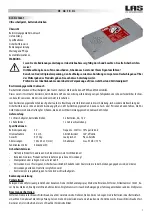
M50 Hardware Design
M50_HD_V2.0
- 51 -
Table 13: AOUT3 output characteristics
Parameter
Condition
Min
Typ
Max
Unit
RMS power
8ohm load
VBAT=4.3V
THD+N=1%
800
mW
8ohm load
VBAT=3.7V
THD+N=1%
700
mW
Gain adjustment range
0
18
dB
Gain adjustment steps
3
dB
3.10.1. Decrease TDD noise and other noise
The 33pF capacitor is applied for filtering out 900MHz RF interference when the module is
transmitting at GSM900MHz. Without placing this capacitor, TDD noise could be heard.
Moreover, the 10pF capacitor here is for filtering out 1800MHz RF interference. However, the
resonant frequency point of a capacitor largely depends on the material and production technique.
Therefore, customer would have to discuss with its capacitor vendor to choose the most suitable
capacitor for filtering out GSM850MHz, GSM900MHz, DCS1800MHz and PCS1900MHz
separately.
The severity degree of the RF interference in the voice channel during GSM transmitting period
largely depends on the application design. In some cases, GSM900 TDD noise is more severe;
while in other cases, DCS1800 TDD noise is more obvious. Therefore, customer can have a
choice based on test results. Sometimes, even no RF filtering capacitor is required.
The capacitor which is used for filtering out RF noise should be close to RJ11 or other audio
interfaces. Audio alignment should be as short as possible.
In order to decrease radio or other signal interference, the position of RF antenna should be kept
away from audio interface and audio alignment. Power alignment and audio alignment should not
be parallel, and power alignment should be far away from audio alignment.
The differential audio traces have to be placed according to the differential signal layout rule.
3.10.2. Microphone interfaces design
AIN1 and AIN2 channels come with internal bias supply for external electret microphone. A
reference circuit is shown in the following figure.
Quecctel
Confidential
















































